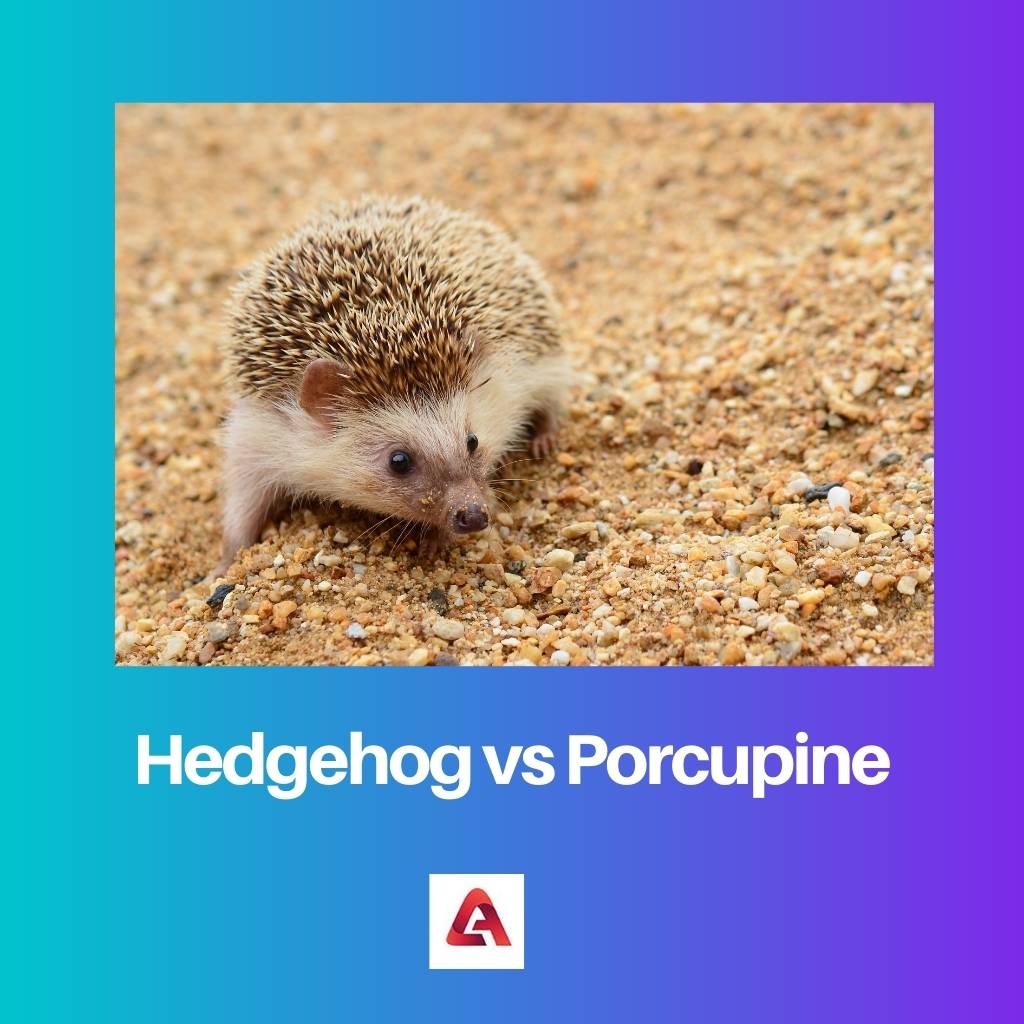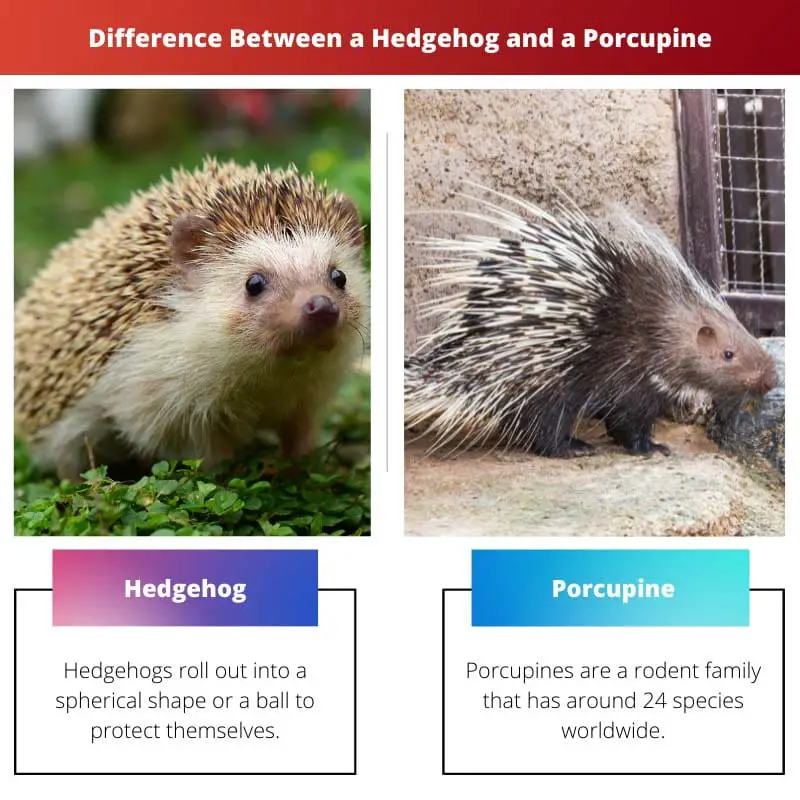Hedgehogs and porcupines are thorny creatures. Because they both have needle-like sharp quills on their bodies, they are frequently misidentified. However, that is about the only thing the two species have in common.
Hedgehogs and porcupines have different diets, defensive behaviors, habitats, sizes, and other characteristics. Their quills also differ in appearance.
Key Takeaways
- Hedgehogs are smaller and have shorter quills that are not barbed.
- Porcupines are larger and have longer quills that are barbed and detachable.
- Hedgehogs are mainly insectivores, while porcupines are herbivores.
Hedgehog vs Porcupine
A hedgehog is a small nocturnal mammal known for its spiky coat of quills that it can roll into a ball for protection, native to Europe, Asia, and Africa. A porcupine is a larger, New World rodent possessing long, sharp quills as a defensive mechanism, which it can raise and shake when threatened.

Hedgehogs roll out into a spherical form or a ball to protect the soft parts of their bodies, and their spines are erected outwards to defend them. As a result, they choose wisely how to defend themselves from predators.
Mice, tiny snakes, and frogs are all prey for hedgehogs. As they are entirely insectivores, their major food consists of insects.
A hedgehog has 5,000 quills (spines).
Porcupines belong to the rodent family, and there are over 24 kinds worldwide. Porcupines are notable for having longer quills, measuring two to three inches in length. Their quills, on the other hand, are easily removed.
Porcupines have roughly 30,000 quills on their bodies. To hit the assailant, porcupines raise their quills after arching their backs and flailing their tails.
The quills cling to the predator and are tough to remove.
Comparison Table
| Parameters of Comparison | Hedgehog | Porcupine |
|---|---|---|
| Species count | 17 | More than 24 |
| Quills/ Spine | Quills are around 1 inch long, remain forever. | Quills are 2-3 inches long, fall off. |
| Quills in quantity | 5000 | 30,000 |
| Self-defence | Roll out, erect quills. | Arch, the back, hit with a tail full of quills. |
| Found in | Northern Africa, Europe. | Canada, Alaska and Northeastern USA, western USA |
| Way of nutrition | Insectivores. | Herbivores. |
| Size | 4-12 inches, tail- 2 inches. | 20-36 inches, tail- 8-10 inches |
What is a Hedgehog?
Hedgehogs roll out into a spherical shape or a ball to protect themselves, and their spines are erected outwards to protect the soft parts of their bodies. As a result, they wisely defend themselves against predators.
Hedgehogs are most commonly seen in Northern Africa and Europe.
Hedgehogs consume mice, tiny snakes, and frogs on occasion. However, because they are primarily insectivores, their major food consists of insects. Hedgehogs can grow to be four to twelve inches long, with a two-inch tail.
There are 17 different species of hedgehogs, as well as moles and shrews.
Hedgehogs have spines, which are similar to quills but smaller. These spines are about an inch long, and the quills stay with them for the rest of their lives, save when quilling as a baby.
Hedgehogs have 5,000 quills or spines on each of their bodies.

What is a Porcupine?
Porcupines are a rodent family that has around 24 species worldwide. Longer quills, measuring two to three inches in length, are characteristic of porcupines. Their quills, on the other hand, are easy to lose.
Porcupines have roughly 30,000 quills in their possession.
After arching their backs and flailing their tails, porcupines raise their quills in an attempt to strike the attacker. The predator is entangled in the quills, making it impossible to dislodge them.
Porcupines are found in many places of the world, particularly in Canada, Alaska, and the northeastern and western United States. Because they are herbivores, porcupines eat green leaves, fruits, grass, stems, and bark.
Porcupines can reach a length of twenty to thirty-six inches, with a tail that is eight to ten inches long.

Main Differences Between a Hedgehog and a Porcupine
- Hedgehogs have a total of 17 different species, which also include moles and shrews. On the other hand, Porcupines constitute more than 24 species worldwide, and they belong to the rodent family.
- Hedgehogs have spines, which are the smaller version of quills. These spines are around 1 inch long, and the quills remain forever with them except at the time of quilling as a baby. On the other hand, porcupines are known to have quills of longer length, which are around two to three inches long. However, their quills fall off easily.
- The number of quills or spines possessed by a hedgehog is 5,000. On the other hand, the number of quills possessed by Porcupines is around 30,000.
- To protect themselves, hedgehogs roll out into a spherical shape or a ball, and the spines are erected outwards to protect the soft part of the body. Hence, they protect themselves from predators wisely. On the other hand, Porcupines stick their quills up after arching their back and waving their tail so that to hit the attacker. The quills stick to the predator, which is difficult to be removed.
- Hedgehogs are found in parts of Northern Africa and Europe. On the other hand, some species of porcupines are found all over the world, but especially in parts of Canada, Alaska, and the Northeastern, western USA.
- Hedgehogs sometimes eat mice, small snakes, and frogs. However, the main diet consists of insects as they are purely insectivores. On the other hand, porcupines eat green leaves, fruits, grass, stems, and bark, as they are herbivores.
- Hedgehogs’ length varies from four to twelve inches, and their tail also grows to two inches. On the other hand, the length of the porcupines grows to twenty to thirty-six inches long, and the tail grows around eight to ten inches.


This detailed analysis of hedgehogs and porcupines is quite enlightening. The article presents a wealth of knowledge on their distinct features.
Absolutely, the scientific details and specific characteristics covered here are truly enlightening and intellectually stimulating.
I’m impressed by the depth of information provided. It’s evident that the content is well-researched and academically sound.
The comprehensive analysis of hedgehogs and porcupines is intellectually enriching. The clear distinctions highlighted contribute to a deeper understanding of these species.
Agreed, the meticulous comparison and detailed examination of hedgehog and porcupine characteristics are impressive. This is a valuable educational resource.
The scientific depth and intellectual clarity exhibited in this article are exemplary. It offers a sophisticated analysis of these intriguing animals.
I appreciate the thorough comparison between hedgehogs and porcupines. The information is presented clearly and concisely.
Yes, the article provides a comprehensive overview of the distinctions between these two species. Well-organized content.
I found the comparison table to be particularly helpful in understanding the key differences. Great emphasis on educational content.
The article delivers an intellectually stimulating comparison of hedgehogs and porcupines. It provides valuable insights into their biological distinctiveness.
Absolutely, the biological insights uncovered here are exceptional. It’s a testament to the scientific rigor and scholarship embedded in this content.
The in-depth comparison between hedgehogs and porcupines is commendable. The article offers a rich understanding of their unique traits and behaviors.
I couldn’t agree more. The content is highly informative and enhances our knowledge of these fascinating creatures.
The scientific rigor and comprehensive analysis in this article are truly praiseworthy. A valuable read for those interested in wildlife.
Fascinating information about hedgehogs and porcupines! Their differences in diet, behavior, and habitat are truly intriguing.
Definitely learned a lot about hedgehogs and porcupines from this article. Their intricate characteristics are remarkable.
Agreed, the details shared here are quite captivating. Thank you for the clear comparison.
The detailed examination of hedgehogs and porcupines is intellectually stimulating. It offers valuable insights into their unique physical and behavioral differences.
The nuanced comparison and scientific rigor presented here are impressive. It’s a valuable resource for understanding the distinctiveness of hedgehogs and porcupines.
Absolutely, the analytical depth and intellectual engagement of this article are commendable. A compelling exploration of these captivating animal species.
The wealth of information presented in this article is commendable. It expands our knowledge of these remarkable creatures and their adaptive features.
Absolutely, the scholarly approach and educational value of this content are evident. It’s a compelling read for those with an interest in wildlife diversity.
I appreciate the nuanced understanding of hedgehogs and porcupines offered in this article. It provides a sophisticated exploration of their ecological characteristics.
This article provides an outstanding analysis of hedgehogs and porcupines. The details about their self-defense mechanisms and dietary habits are captivating.
I’m impressed by the depth of content and the thorough examination of hedgehog and porcupine characteristics. A well-articulated and educational piece.
The comparison between hedgehogs and porcupines is thought-provoking. It sheds light on their ecological roles and adaptability in different environments.
Indeed, the ecological insights offered in this article are profound. It’s an intellectually enriching exploration of these unique animals.